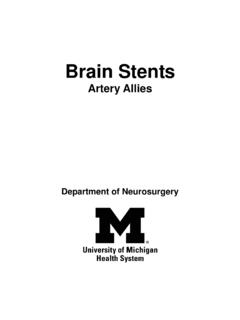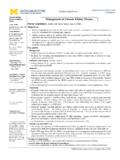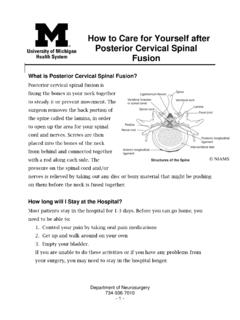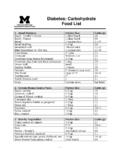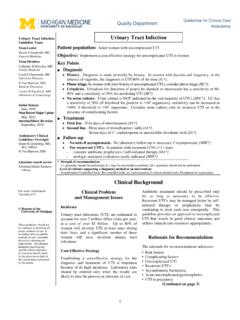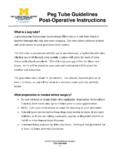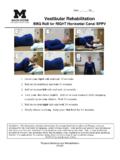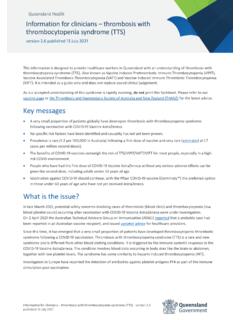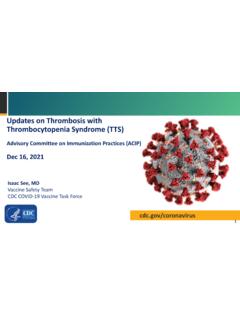Transcription of Sequential Compression Device (SCD) - Michigan Medicine
1 UMHS Nursing Units - 1 - Protect Yourself from Deep Vein thrombosis with Sequential Compression Device (SCD) Deep Vein thrombosis (DVT) What Does it Mean? DVT (Deep Vein thrombosis ) occurs when a blood clot develops in one of the deep veins in the body. Without treatment a DVT can cause a potentially life threatening condition called Pulmonary Embolism (PE). PE occurs when a blood clot breaks off from a vein and travels to the lungs. Could I Be At Risk? Most hospitalized people have at least one risk factor for DVT. Some risk factors are: Age over 40 Smoking Being bedbound Having one of the following conditions: o Chronic lung disease o Heart failure o Serious infection o Recovering from surgery o Inflammatory bowel diseases o Cancer o Varicose veins Deep vein thrombosis is the formation of a thrombus (blood clot) within a deep vein, most often in the thigh or calf.
2 Reproduced with permission from OrthoInfo. American Academy of Orthopaedic Surgeons. UMHS Nursing Units Sequential Compression Device (SCD) - 2 - How Do I Prevent It? Sequential Compression Device (SCD) is a method of DVT prevention that improves blood flow in the legs. SCD s are shaped like sleeves that wrap around the legs and inflate with air one at a time. This imitates walking and helps prevent blood clots. You should wear your SCD s any time you are in bed or sitting in a chair. The SCD s must be removed for walking. Foot exercises are also important to prevent the formation of a blood clot. Point your toes toward the bottom of the bed, then up toward your face. Repeat 10 times each hour you are awake. You should also be out of bed as much as you are in bed and walk in the halls at least six times per day if your doctor approves it.
3 If you are on fall precautions, ask for assistance before you get out of bed. How Do I Know If I Have A DVT? The most common symptoms of a DVT are swollen and tender calves. Other symptoms include: Red areas on the leg Swelling in one area or on one leg Pain or tenderness in one leg An area on the leg that feels much warmer to the touch If you notice any of these symptoms, let your nurse or doctor know right away. UMHS Nursing Units Sequential Compression Device (SCD) - 3 - Disclaimer: This document contains information and/or instructional materials developed by the University of Michigan Health System (UMHS) for the typical patient with your condition. It may include links to online content that was not created by UMHS and for which UMHS does not assume responsibility. It does not replace medical advice from your health care provider because your experience may differ from that of the typical patient.
4 Talk to your health care provider if you have any questions about this document, your condition or your treatment plan. Author: Crystal Curtis, BSN, RN. Reviewer: Mary Lynn Parker, , , Unless otherwise noted University of Michigan Health System Patient Education is licensed under a Creative Commons Attribution-NonCommercial-ShareAlike Unported License. Last Revised 7/24/2013 What are the dangers of a DVT? If you get a DVT, you may find yourself with: Pain Pulmonary Embolism (PE). This can be life-threatening. A longer hospital stay An increased chance of getting another blood clot in the future Additional treatment after you leave the hospital Why put yourself at risk? Using your SCD s will help you avoid these problems. Be Your Own Advocate DVT s can develop no matter how careful you are with your health but you can take action to prevent them.
5 Educate yourself about the risk factors and take steps to prevent DVT s from occurring; use your SCD s, do the foot exercises and get out of bed. Be your own health advocate! Where can I learn more about preventing a blood clot? To view a video about what you can do to prevent a blood clot in the hospital visit: In the Keywords search box type: DVT prevention Hit the Search button. Select the video Working Together to Prevent Blood Clots from the list
